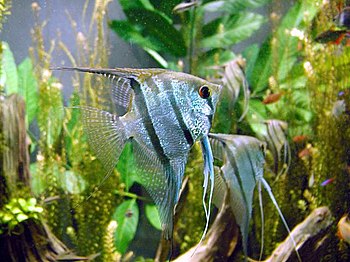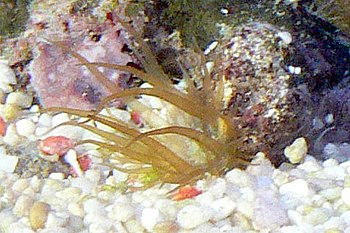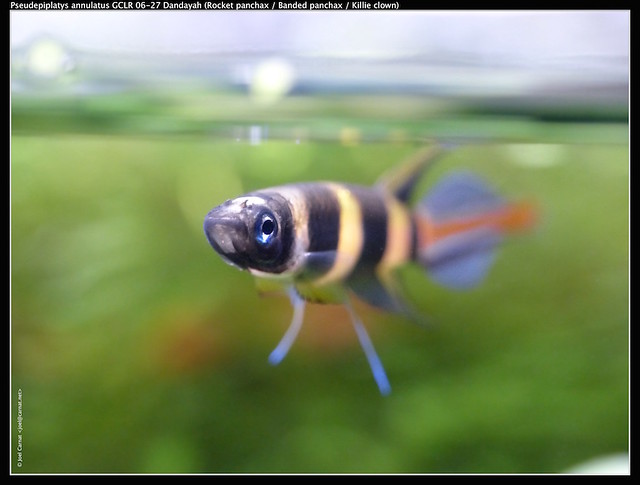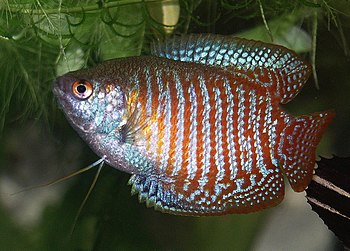Centropyge acanthops - Photo: Wikipedia (CC)
|
This is a small fish, even for dwarf angles. It only grows to a maximum adult length of 3 inches. What they lack in size they more than make up for an exotic beauty. This is one of the most striking of all the dwarf angles. The bottom half of their bodies are a royal purplish blue. This is contrasted by dazzling yellow-orange upper bodies. The upper body color starts just below their mouths sweeps upward behind their eyes and then follows the curvature of their backs all the way to the base of their tails, hence the name Flameback. Dorsal, anal and pectoral fins are accented in neon blues. Caudal fins are typically yellow and semi-transparent.
This species is very similar in appearance to the Brazilian flameback angelfish even though they are entirely different species. Brazilian Flamebacks can be distinguished by their solid blue caudal fins. This species is sold by the aquarium industry under several pseudonyms including; African Flameback angel, African Pygmy Flameback Anglefish, African Cherubfish, Orangeback Angelfish, and Jumping bean. The latter reference should imply that this fish needs to be housed in a tightly lidded aquarium.
This fish has a moderately aggressive temperament. They are generally peaceful in a community setting provided they are in the company of equally sized or slightly larger fish that are not docile in nature. This species may be reef compatible if it is introduced to your tank as a small juvenile. An abundance of cured live rock will help deter the possibility that it will develop a taste for coral and mollusks as it matures. Flamebacks may express territorial behavior toward similar looking species. These are harem fish. A single male and several females can be successfully housed together. The introduction of two males into an aquarium could easily result in a battle to the death. This species is rated at a moderate care level. A minimum tank size of 20 gallons with plenty of hiding spaces is recommended. Flamebacks can live up to 8 years of age.
This is an omnivorous species. Juveniles are primarily planktonic feeders. Adults learn more toward being algaevores. They will, however, also eat small crustaceans, mollusks, and coral in their natural habitat. This is why only a very young flamebacks should be added to a marine reef aquarium. If the fish's diet consists of plankton, it can be conditioned to finding all the sustenance it requires in supplied aquarium foods and lives rock before it develops its adult dietary habits. A well-fed fish will be less likely to discover that clams and corals are its favorite taste treat.
These fish should be fed a high-quality marine angelfish food preparation. Foods formulated especially for angelfish contain the essential nutrients needed to maintain a healthy specimen. Its diet can be further supplemented with vitamin enriched brine shrimp, mysis shrimp and dried or frozen spirulina algae.
There is more than one benefit to buying this species when they are still quite young. There are no distinguishing characteristics between males and females. Thus you will not be able to determine their sexes. Two males cannot be housed in the same aquarium together.
Problem solved: These fish are protogynous synchronous hermaphrodites. They enter life genderless. They will all develop into females early in their lifecycles. If there are no males present in the population as they reach sexual maturity, the largest most dominant fish will change into a male. The introduction of several of these fish when still young into an aquarium will result in a single male with a harem just as it would in nature. Despite their ability to change gender, these fish have not been known to breed in captivity.
Saltwater fish and marine reef aquariums are fun and rewarding hobbies. Just thirty years ago the thought of successfully maintaining a home nano reef was almost unheard of. Less than a decade ago Jellyfish Fish Tank Aquariums were only found in large public aquarium facilities. Raising Moon Jellyfish & Pet Jellies is the hottest new trend in home aquarium ownership. Article Source: EzineArticles |







